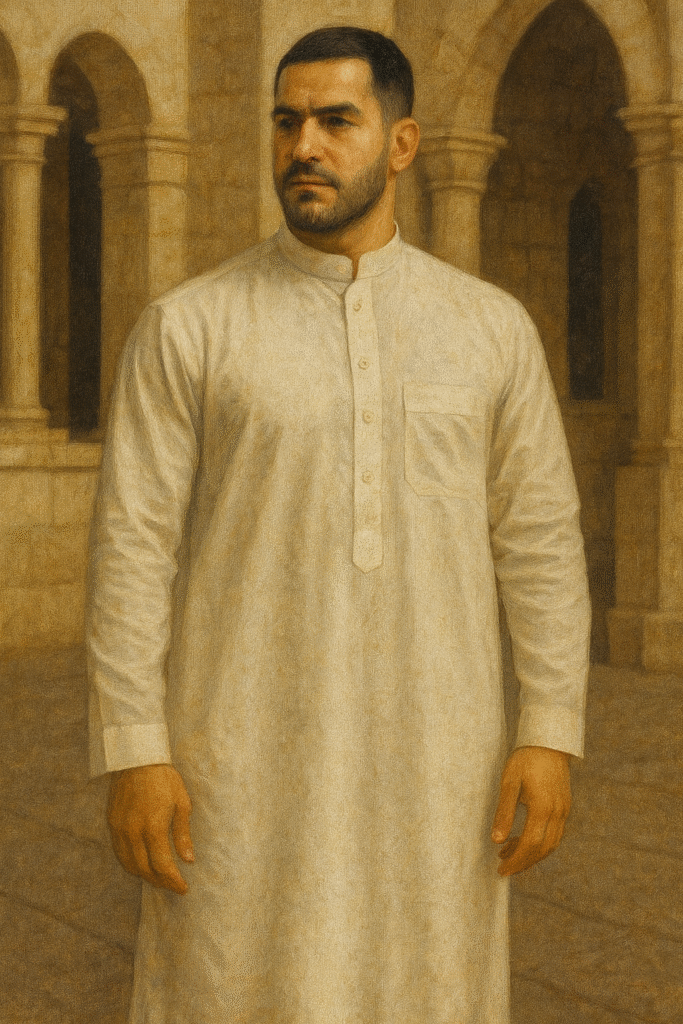Introduction
How to choose qamis? A qamis (also spelled thobe or dishdasha) is a long tunic worn by men in many Muslim communities. It embodies modesty and cultural identity, while allowing the wearer to look elegant and feel comfortable. Choosing the right qamis is both an art and a practical matter, because the garment’s cut, fabric and details should align with your body shape, climate and occasion.
Take accurate measurements
Take accurate measurements
The starting point for any qamis is a precise fit. Measure your height from the base of your neck to the ankle or the desired hem length. Measure the shoulder width between the points where the sleeves meet your shoulders, the sleeve length from shoulder to wrist, and the circumference of your chest. These measurements will ensure that the garment covers you appropriately without being too tight or too loose. Proper fit is important for modesty and comfort; a garment that is too short may ride up when sitting or raising your arms, while one that is too long may restrict your movements or drag on the floor (Master the art of making the perfect qamis in 2023). If you are ordering online, consult size charts provided by manufacturers and consider contacting a tailor for custom adjustments.
Choose the right fabric
Fabric selection affects how the qamis looks and feels. Natural fibers like cotton and linen offer breathability and softness, making them perfect for warm climates and everyday wear (Master the art of making the perfect qamis in 2023). Cotton is easy to maintain and resists wear, while linen has a crisp texture and wicks moisture. For formal events or cooler weather, you might select satin, polyester blends or wool mixes; these fabrics can have a subtle sheen and drape gracefully. In Gulf countries, shiny polyester fabrics are popular for their durability and lustre (Explaining The Different Types Of Thobe – Al Aniq). However, they may feel warmer and are less breathable. Consider the climate and season when choosing your fabric. Lighter weaves and airy fibers work better in hot summers, whereas heavier weaves and lined garments are more suitable in winter.
Pay attention to cut and details
The silhouette and details of a qamis vary by region and personal taste. Saudi thobes often have structured collars and cuffs and may close with buttons or concealed zippers, giving them a tailored look. Emirati kanduras are collarless and feature long tassels dangling from the neckline (Explaining The Different Types Of Thobe – Al Aniq). Omani and Qatari styles might have simple collars, one button or no button at all. North African “djellabas” and Moroccan qamis usually include a pointed hood and colourful stripes. South Asian kurtas tend to have side slits and can be worn over trousers or shalwar. Think about how these design elements reflect your identity and desired look. Embroidery along the placket, cuffs or hem can add distinction, while pockets and chest buttons add functionality.
Modern trends and customization
Contemporary designers have reimagined the qamis with modern touches. In recent years, two-tone and colour-blocked designs have become popular, as have satin fabrics in both neutral and vibrant hues (Latest Qamis Muslim Trend: Style & Trends for 2025). Athletic or tapered cuts offer a streamlined silhouette without sacrificing modesty. Some brands allow customization of collar shapes, cuff styles, and even personalised monograms or embroidery. If you wish to stand out, look for unique patterns, contrast piping or subtle prints. However, remember that understated elegance often has greater longevity than flashy designs.
Consider occasion and accessories
How to choose qamis: your choice of qamis should match the situation. For Friday prayers, weddings and other formal events, choose conservative colours such as white, cream, black or deep navy, perhaps with delicate embellishments. For everyday wear, earthy tones like olive, beige or grey can be paired with simple sandals or loafers. In cold weather, layering with a shawl or wearing a bisht (a cloak-like garment) adds both warmth and sophistication. Accessories such as a shemagh or keffiyeh (headscarf) can complement the look; choose colours and patterns that harmonize with your qamis. A leather belt can provide definition at the waist if the garment is loose-fitting, while a prayer cap (kufi) can complete the ensemble.
Evaluate craftsmanship
Guide to choosing your qamis: sizes, fabrics and tips
Evaluate craftsmanship
/image

A qamis (also spelled thobe or dishdasha) is a long tunic worn by men in many Muslim communities. It embodies modesty and cultural identity, while allowing the wearer to look elegant and feel comfortable. Choosing the right qamis is both an art and a practical matter, because the garment’s cut, fabric and details should align with your body shape, climate and occasion.
Take accurate measurements
The starting point for any qamis is a precise fit. Measure your height from the base of your neck to the ankle or the desired hem length. Measure the shoulder width between the points where the sleeves meet your shoulders, the sleeve length from shoulder to wrist, and the circumference of your chest. These measurements will ensure that the garment covers you appropriately without being too tight or too loose. Proper fit is important for modesty and comfort; a garment that is too short may ride up when sitting or raising your arms, while one that is too long may restrict your movements or drag on the floor (Master the art of making the perfect qamis in 2023). If you are ordering online, consult size charts provided by manufacturers and consider contacting a tailor for custom adjustments.
Choose the right fabric
Fabric selection affects how the qamis looks and feels. Natural fibers like cotton and linen offer breathability and softness, making them perfect for warm climates and everyday wear (Master the art of making the perfect qamis in 2023). Cotton is easy to maintain and resists wear, while linen has a crisp texture and wicks moisture. For formal events or cooler weather, you might select satin, polyester blends or wool mixes; these fabrics can have a subtle sheen and drape gracefully. In Gulf countries, shiny polyester fabrics are popular for their durability and lustre (Explaining The Different Types Of Thobe – Al Aniq). However, they may feel warmer and are less breathable. Consider the climate and season when choosing your fabric. Lighter weaves and airy fibers work better in hot summers, whereas heavier weaves and lined garments are more suitable in winter.
Pay attention to cut and details
The silhouette and details of a qamis vary by region and personal taste. Saudi thobes often have structured collars and cuffs and may close with buttons or concealed zippers, giving them a tailored look. Emirati kanduras are collarless and feature long tassels dangling from the neckline (Explaining The Different Types Of Thobe – Al Aniq). Omani and Qatari styles might have simple collars, one button or no button at all. North African “djellabas” and Moroccan qamis usually include a pointed hood and colourful stripes. South Asian kurtas tend to have side slits and can be worn over trousers or shalwar. Think about how these design elements reflect your identity and desired look. Embroidery along the placket, cuffs or hem can add distinction, while pockets and chest buttons add functionality.
Modern trends and customization
Contemporary designers have reimagined the qamis with modern touches. In recent years, two-tone and colour-blocked designs have become popular, as have satin fabrics in both neutral and vibrant hues (Latest Qamis Muslim Trend: Style & Trends for 2025). Athletic or tapered cuts offer a streamlined silhouette without sacrificing modesty. Some brands allow customization of collar shapes, cuff styles, and even personalised monograms or embroidery. If you wish to stand out, look for unique patterns, contrast piping or subtle prints. However, remember that understated elegance often has greater longevity than flashy designs.
Consider occasion and accessories
Your choice of qamis should match the situation. For Friday prayers, weddings and other formal events, choose conservative colours such as white, cream, black or deep navy, perhaps with delicate embellishments. For everyday wear, earthy tones like olive, beige or grey can be paired with simple sandals or loafers. In cold weather, layering with a shawl or wearing a bisht (a cloak-like garment) adds both warmth and sophistication. Accessories such as a shemagh or keffiyeh (headscarf) can complement the look; choose colours and patterns that harmonize with your qamis. A leather belt can provide definition at the waist if the garment is loose-fitting, while a prayer cap (kufi) can complete the ensemble.
Evaluate craftsmanship
How to choose qamis: your choice of qamis should match the situation. For Friday prayers, weddings and other formal events, choose conservative colours such as white, cream, black or deep navy, perhaps with delicate embellishments. For everyday wear, earthy tones like olive, beige or grey can be paired with simple sandals or loafers. In cold weather, layering with a shawl or wearing a bisht (a cloak-like garment) adds both warmth and sophistication. Accessories such as a shemagh or keffiyeh (headscarf) can complement the look; choose colours and patterns that harmonize with your qamis. A leather belt can provide definition at the waist if the garment is loose-fitting, while a prayer cap (kufi) can complete the ensemble.
Caring for your qamis
Maintenance depends on the fabric. Cotton and linen qamis are uszually machine washable in cold or warm water and should be hung to dry to prevent shrinking. Satin or heavily embroidered garments may require gentle hand washing or dry cleaning. Always read care instructions and avoid harsh detergents or bleach. Iron the garment on the appropriate setting; steam may help remove wrinkles without direct heat. Proper care will keep your qamis looking fresh and extend its life.
For more options, visit our Qamis collection. Explore our Qamis collection for a wide range of styles.
